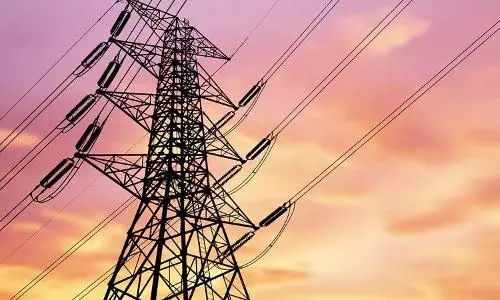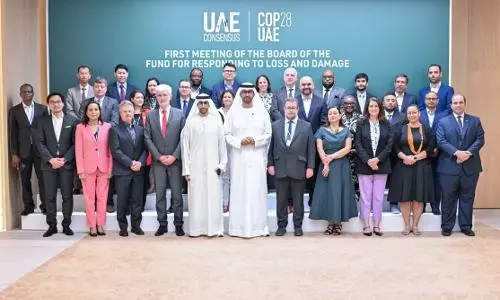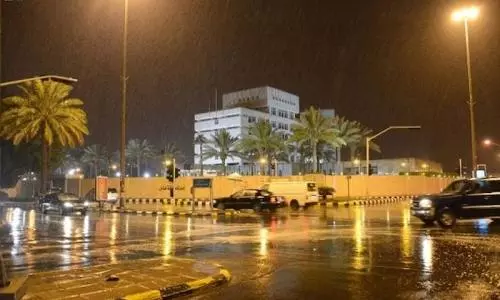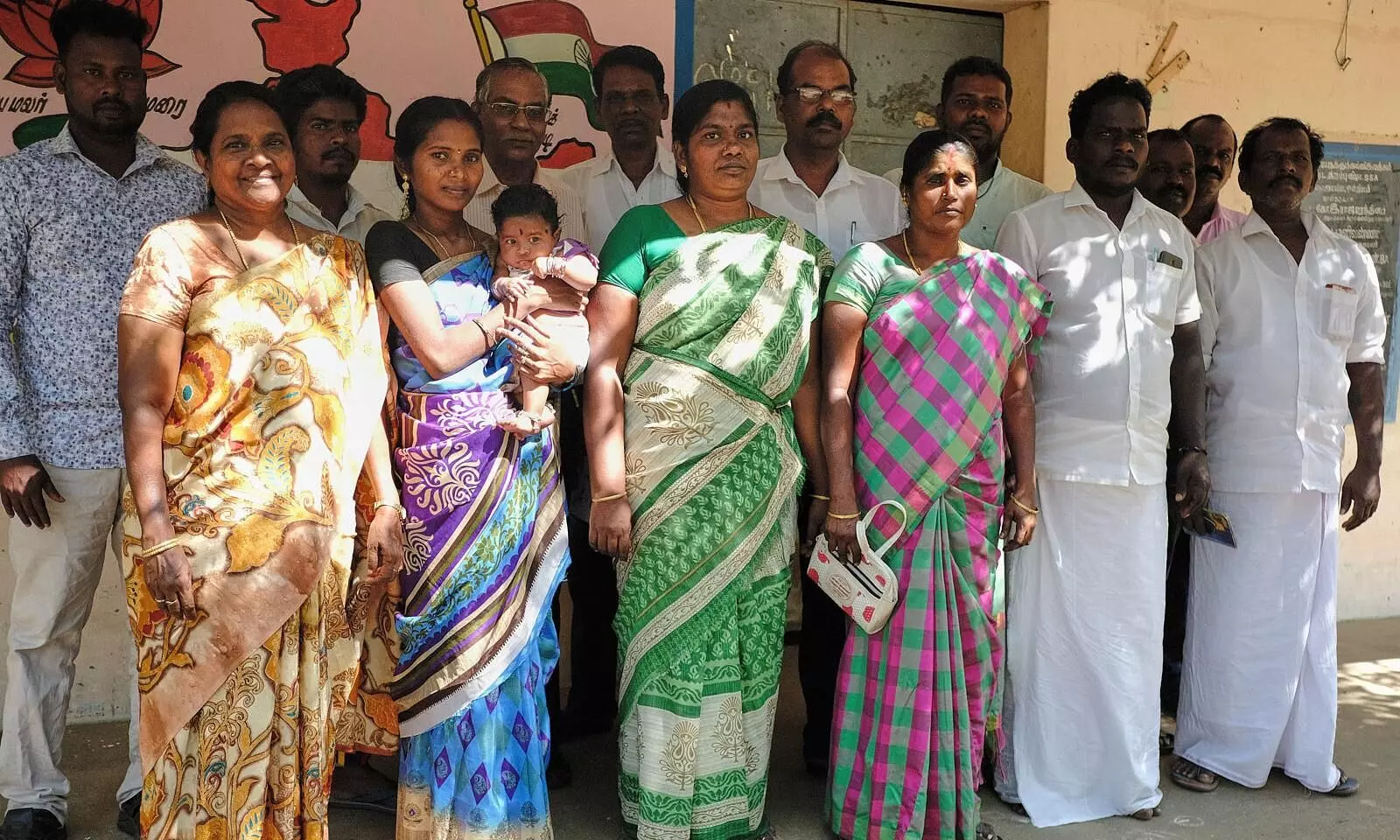
No Land Rights 'Insurance' for Dalit Survivors of Cyclone Gaja
text_fieldsSurvivors of Gaja gather in the school building where they took shelter when the cyclone hit (Photo by: Monica Jha)
Ananda Jyothi spends many sleepless nights. She gets worried when it rains. Every time the wind turns heavy, her anxiety rises. Her coastal village— Naluvethapathy— sits on the mouth of the Addapar River in Nagapattinam district in Tamil Nadu.
Disasters have become more frequent and very unpredictable, she says. The whole of Nagapattinam and Tamil Nadu coast is vulnerable. But, she has more to lose. "I'm worried because I don't own any land," she says.
In Nagapattinam, when disaster strikes, caste and landlessness combine to menacing effect.
Jyothi knows this from her experience of the Gaja cyclone in November 2018. The Gaja cyclone — the worst to have struck the Cauvery delta since 1993 — killed 46 people and displaced over 2.5 lakh people. Farmers lost their crops and found their coconut plantations uprooted. People lost their cattle, goats, and poultry. Fishermen were left with the wreckage of their boats. Nagapattinam was one of the most affected districts, besides Thanjavur, Thiruvarur, Pudukottai, Karaikal, Trichy and Ramanathapuram.
The devastation was so extensive that Chief Minister Edappadi Palaniswami announced a Rs 1000 crore relief package — a considerable amount in India's typical meagre response to natural disasters.
Loss caused by Gaja |
● It killed 46 people.
● It displaced over 2.5 lakh people.
● It caused the loss of 270 cattle, 1181 goats and 15000 birds.
● It caused the destruction of 4844 fishing boats and 56,000 hectares of crops, and degradation of around 88102 hectares of agricultural lands and damage to 18,000 hectares of a coconut plantation. |
Rs 1000 crore Relief Package |
● Rs 350 crore was allocated as compensation for the farmers who have lost their crops
● Rs 205.87 crore as a relief for the loss of life, cattle and possessions
● Rs 100 crore damages to houses
● Rs 41.63 crore for loss of boats of fishermen
● Rs 102.50 crore for infrastructure includes roads and waterways
● Rs 200 crore to restore electricity in the regions hit by the cyclone. |
Many in Jyothi's 4,500-strong village, who were into farming or fishing, received compensation for their losses.
But, Jyothi wasn't entitled to free rebuilding of houses by the government and compensation for loss of livelihood and property. Why? Because she doesn't own the land she lives on. This despite the fact that she has been paying house tax and electricity bills for many years.
"When the government provides electricity or water and collects bills, it doesn't ask for if I've a right to live on this land. But, whenever we ask for government housing schemes, they ask us to show patta," Jyothi says.
She lives on maniayam land and has no patta (land ownership right). Maniyam lands were revenue-free land given to specific individuals or institutions by rulers. In Jyothi's village, 66 Dalit families live on maniyam land, originally owned by an Iyer brahmin man. He brought some Dalit families to work on it. Soon their relatives came and settled here as well. Today, the fourth generation of the original settlers live here. Yet, the patta is still in the name of the original Brahmin owner, whose descendants are unknown.
These settlers have been asking the government for years to issue patta in their names. The Tahsildar refuses to issue a new patta, says Jyothi. "He says 'you can't tie a thali (bride's necklace), when there's tied one already'," she adds. He told them to find the descendants of the original owner and have the land transferred in their names.
"After Gaja, upper-caste landowners received compensation even for fallen coconut trees. But we received nothing for the loss of our livelihoods," Jyothi says.
"If you don't own land, you don't exist in the government's eyes."
In the aftermath of Gaja, the patta proved crucial again to access rehabilitation schemes.
Senthil Kumar J of the neighbouring Tamaraipuram village had decided to rear goats, after agricultural jobs in the region disappeared as farming lands were ruined by the increased salinity. "I had saved up money to build a shed and was looking for capital to buy 30 goats. But, no bank agreed to give me a loan since I didn't have land for collateral." His house didn't count since it is built on Poramboke land and doesn't have patta in his name. Poramboke is land that doesn't come under varam or revenue assessment and is not available for cultivation; it usually consists of punjai (dry) lands.
This lack of livelihood options have pushed people out of their villages. For women in particular, who migrate to Tirupur and Coimbatore to take up jobs in the garment industry, it has been very tough. K Uttharapathy, vice president of Kallimedu village panchayat says that many of them have been sexually abused and physically exploited in their jobs.
As he says this, other men in the room nod; women look away.
"It breaks our heart to listen to their stories; we feel helpless. They wouldn't have to undergo this if they had better options," says Utthrapathy.
*****
Land rights has become a pressing issue as Nagapattinam becomes increasingly climate stressed and vulnerable to sea level rise, erosion, and storms.
Besides the 2004 tsunami and the 2018 Gaja cyclone, the region has witnessed several sea and wind storms, erratic rainfall, salt water intrusion and droughts, says Murugesan who heads the Dalit People's Coalition of 26 villages.
Traditional wisdom to predict disasters doesn't work anymore and the government issues no forewarning or announcements, he adds.
"There is no place to go when disaster strikes. Dalits, who have insecure housing, are the most vulnerable."
To add to this are government-made disasters, says Senthil N, another leader of the Coalition, from Maruthur-North village.
He is referring to the longstanding industry-agriculture clash in the region. "There are 10 power plants in nearby villages in Nagapattinam district alone and the government is pushing Sagarmala."
Sagarmala refers to a series of projects worth INR 4 lakh crore which would connect waterways and develop port areas to create a logistics corridor and coastal economic zones.
Rampant sand mining and shrimp farming have also added a lot of pressure on resources and contributed to a high rate of farmer suicides.
"With so many projects vying for our land, we fear losing the land we live on," Senthil says.
"They can kick us out anytime," adds Jyothi. "If I don't have a patta, how will I show them I've lived here? They won't relocate or rehabilitate me. They will just throw me out."
"Patta would make me entitled for rehabilitation and not dependent on charity."
In Naluvethapathy, Jyothi and 65 other families live on the Adapar riverbed, which floods every monsoon.
"The places where we stay are unfit for human habitation," says Kasi Mariappan, Jyothi's neighbour. "These are low-lying areas on the margins of the village. Nobody wants to live there but still, they wouldn't let us have it."
In the neighbouring Thathanthiruvasal village, 197 Dalit families and 40 backward caste families stay on the either side of Harichandra river.
Thamaraiselvan, a resident, says that when the river gets flooded, we have no place to live. We pitch plastic sheet tents wherever we can find a small dry patch of land. This is how we live for six months every year. In other months, we live on land slush with drain water and stagnant rain water."
None of the Dalit families in his village have patta of the Poramboke land they live on. Dalits live in thatch houses and others in tiled roof houses. Gaja destroyed them all.
In Senthil's Maruthur-North village, over 300 out of the total 450 Dalit families live on temple land. They don't have formal ownership rights over it.
Muthu Lakshmi of Avarikkadu village has been trying to get a patta issued in her family's name for the last two years. She lives on natham poramboke land in a joint family. "We live in the same house but it's actually three families of three adult brothers. If we get patta, we can try to build separate huts."
In Uttharapathy's Kallimedu village, 55 out of 155 Dalit families have no patta or permanent house. An NGO had once built 45 tiled houses, which Gaja destroyed.
P Revathy of Kadanthethi village says that over 150 families in her village don't have pattas. All of them are Dalits. The houses are built with thatch and plastic sheets.
Three out of four Dalit households in rural Tamil Nadu are landless and dependent on manual casual labour for their livelihood, showed the Socio Economic and Caste Census data in 2015. Dalits account for one-fourth of the state's rural households.
The state government is aware of the problem. In 2018, it launched a scheme to issue free patta for poramboke land. It had a provision to give house pattas for four cents of encroachments in rural areas. This included objectionable poramboke lands— water bodies, roads and grazing lands— that are often occupied by Dalits. In September 2019, it extended the scheme by one year.
However, Dalits here have not benefited from the scheme, says Murugesan.
It is not that land isn't available.
Over 1,500 acres of panchami land is available in our area, says Senthil.
Panchami land is land which was distributed for Dalits in Tamil Nadu during the British rule in 1892. It can't be held by or sold to non-Dalits or reclassified as another category of land.
"But, today, none of the 1,500 acres is used by Dalits. People of other castes, mostly Vanniyars, occupy it," says Senthil.
Some of them use this land for agriculture, and some have built houses. Others just fence it and occupy it, leaving it vacant, he says. "There have been instances when they have attempted to sell this land."
In 1977, a Dalit struggle took place here to reclaim panchami land. After a prolonged struggle, 15 dalit families secured control of 15 acres of panchami land. Since then, no more of this land has come under Dalit control, he adds.
They have petitioned the collector three times— in 1993, 2002 and after the tsunami in 2004. "We didn't try it post Gaja. If they didn't do it after the tsunami which killed several people, they wouldn't do it after Gaja. The government refused to consider it serious since Gaja didn't involve a huge loss of life," explains Senthil.
Today, Dalits do not involve in any clash or conflict over panchami land since they're too scared to ask, says Senthil. "They (the other castes) are the brute majority— there are 3,600 non-dalit families and only 75 dalit families. Over 60 dalit families have no land. If we demand our right, there would be violence. And we would get thrashed."
His fear is not baseless.
In 2016, some Vanniyar families were trying to sell some of this panchami land. Dalits got a whiff of it. Over 40 Dalit families approached them. "We asked them to sell the land to us. They refused and chased us away," says Senthil.
"Engaiakku bhayankara bhayam (We are extremely afraid)."
Dalits had to face open discrimination and violence, even in the middle of a natural calamity, when Gaja struck.
In Naluvethapahy, residents set up a relief camp at the village primary school. But, within a couple of days,the Dalits had to move out, says Murugesan. "There was rampant caste-based discrimination."
This wasn't a one-off incident.
Untouchability, discrimination, denial and violence occurred in all Gaja relief camps, says Richard Devadoss, a Dalit land rights activist and author of the report Gaja cyclone: Denial of dignity to Dalits.
He coordinated a survey of over 3,374 Dalit survivors of Gaja cyclone from 41 villages— 29 in Nagapattinam and 12 in Pudukottai districts— between April and June 2019 conducted by Social Awareness Society for Youths (SASY), an NGO. "Based on the survey, I conducted one-on-one interviews with 14 Dalits, including five women, who confirmed humiliating discrimination," says Devadoss.
Devadoss says dominant caste people in Kodiyakkarai village attacked Dalits with knives and iron rods when they tried to get relief materials from an NGO. 'We could have been killed if the police had come a little later', he remembers a man telling him.
Other incidents were less violent but more humiliating.
"'They prevented our elderly from coming to the camp saying they would dirty the place'," Devadoss remembers a woman from Naluvethapathi telling him.
'We were not allowed to use the toilets in the school that were used as the camp. Forced to use open spaces. Women had a difficult time.'
'Only when we demanded our share, the dominant caste gave us left overs of relief material (food, clothes, etc) given by NGOs.'
Other testimonies that Devadoss came across were:
"They got enough supplies to eat three meals a day, we ate only once."
"We were given less drinking water than them and they didn't allow us to drink water from the same drums."
"They received rice, vegetables and other provisions from government officials. But, only rice reached us."
"They told us 'How can we eat food cooked by you, Dalits?'."
"We were told 'We will not eat food cooked in your vessels'."
"They said 'You are not our equals. How can we sit and eat together with you?'."
Within two or three days, the camps were segregated caste-wise, since dominant castes were unwilling to share space with Dalits, says Murugesan. Dalits were forced to stay in the worst rooms at the back of the school while the others stayed in the best rooms in the front, he adds.
Jyothi avoids talking about Cyclone Gaja. It devastated her village. It forced her to live with her family in a relief camp for 26 days. It's this relief camp that she specifically doesn't like talking about.
***
Gaja reminded Dalits, in relief camps and during rehabilitation, of their acute need for land.
Devadoss' study also highlighted that over 30 per cent of respondent families lived on either temple land or Poramboke land.
"About 1018 families have houses on the temple or poramboke land. Of this, 392 Dalit families (12 per cent) lived on temple lands and 616 families (18 per cent) lived on Poramboke land. Neither set had pattas. They pay house tax and electricity bills, but live under constant threat of being thrown out," says Devadoss.
He stresses that the actual number of families requiring patta is much higher. "More than 1600 families lived as joint families; many had parents and two or three brothers with their families. Each individual family would require a separate patta."
His study also established that almost all Dalit houses (with or without patta) are thatched huts or sheds. Of the 3374 documented houses, only 154 were concrete houses. All 3374 houses of Dalits were damaged— 2121 fully and 1253 partially— during Gaja and needed reconstruction, but they received no compensation.
"Over 92 per cent said that no reconstruction was done by the government, even on the patta land. Only 270 houses (8 per cent) were included in the reconstruction," Devadoss says.
"Cash ranging from Rs 3,000 to Rs 9,000 was sporadically deposited in bank accounts of some survivors. But most Dalits received no compensation for loss of trees, livesticks and livelihood resources. Some got Rs 10,000 out of the promised Rs 15,000 compensation," says Devadoss.
Now, fearing more disasters, Dalits in these villages demand homestead land with patta and disaster shelters.
In his report, Devadoss has recommended homestead land of 10 cents, patta for those living on temple and poramboke land, construction of permanent concrete houses with toilets, and disaster shelters for Dalits in every village.
***
Anish, Jyothi's 14-year-old son, spends a lot of time with the elders in the village. He asks them about how long they have lived here, when their family moved here, who else lived here back then, and who owned the land. The last bit is the most important to him.
Anish is trying to trace the ownership of the land he lives on.
"We have been living here for so long that even the most senior citizens here don't know who owned it originally," says Anish.
It's not just Anish but the entire community (all dalit families in the village) that's interested in finding the original owner of the land.
They filed an RTI. The government's response helped them trace the ownership till 1965.
Jyothi is proud of his work, but still cautious. "Anish seems a little obsessed with it," she says.
Jyothi says that her in-laws agonised over not having land all their lives. Now, she loses sleep over it too.
"I don't want my son worrying about being thrown out of our land."
(The author is Bengaluru based freelance journalist. This story has been reported with the assistance of the Impact Journalism Grant 2019)
























